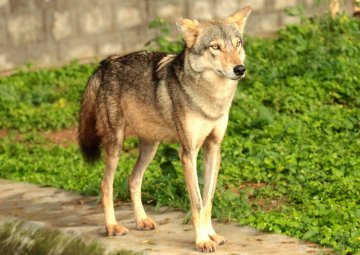Indian Wolf

The Indian Wolf is native to India and other Arabian countries like Pakistan, Iraq, Iran and the United Arab Emirates. The light brown or reddish coloring is the main reason why it is commonly confused for a fox. It is quite small at approximately 3 feet in length and it has a shorter and less dense coat as compared to other wolves. It can weigh up to 45 lbs. This fits their survival needs since they mainly live in warm regions.
Behavior
The Indian wolf can howl just like other wolf species, however, it rarely does. This has been mainly attributed to the fact that they are not as possessive about their territories as other species. Therefore, they do not howl as a warning to other packs that they have staked a claim in a certain location.
Distribution
These wolves can survive in desert like areas and are most commonly found in India. They mainly roam on the open lands. They have been known to frequent areas such as Gujarat and Pradesh.
Diet
The Indian wolf’s diet mainly comprises of small animals and it is what they survive on. This includes rabbits, raccoons and rodents. The pack is mostly spread loosely over a given location and each wolf hunts for its own food. This mainly takes place at night and ends around dusk.
Reproduction
Their mating period is during October which is quite different from other species. However, this has been attributed to the timing of rains which often brings out additional food for this species of wolves. Hence this is partially responsible for the rather strange timing. The mother produces 1-6 pups per litter and she has several dens to enable her to move her pups around often. The pups never come out of the dens until they are about three months old. The entire pack helps to take care of the young as the mother goes to hunt for their food until they are strong enough to join her or hunt for their own food.
Conservation
It is estimated that only about 3,000 of this species remain in the wild. They are kept in captivity in Rajasthan in the Jai Samand Sanctuary. It has been quite hard for conservation efforts to be effective mainly due to the bad reputation of the Indian wolves and the poor economic condition in the areas where they live. For instance, most people feel that the conservation efforts and funds should be spent on helping Indians rather than protecting the Indian wolves. Politics and ethics have continued to frustrate conservation effort.
Human Interaction
The Indian wolf is at conflict with residents living in their habitats mainly because it is known to kill livestock. Therefore, it has become an enemy of most people living in these regions. They are also known to attack people most commonly small children and experts have attributed this to the lack of food in their natural habitat and the environment in general. Even though the Indian Wolf is a protected species, mainly because it is endangered, trapping, hunting and poisoning continues.
